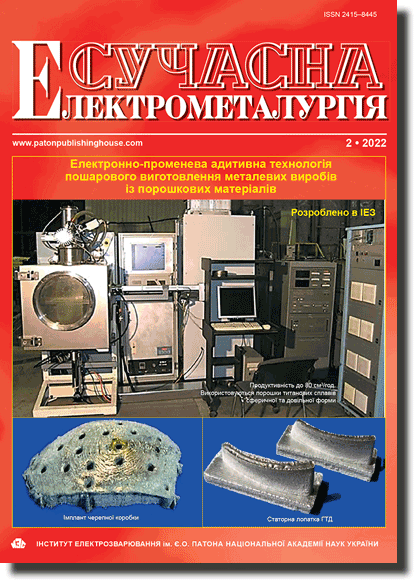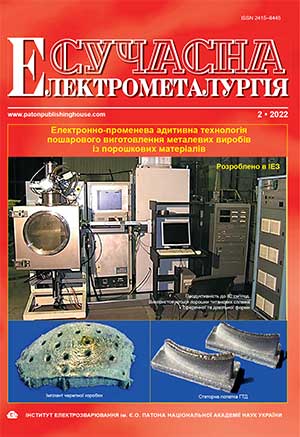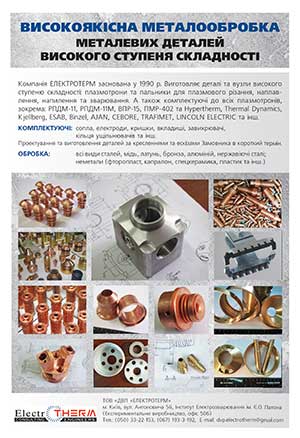| 2022 №02 (02) |
DOI of Article 10.37434/sem2022.02.03 |
2022 №02 (04) |

"Suchasna Elektrometallurgiya" (Electrometallurgy Today), 2022, #2, 17-26 pages
Dispersity and magnetic properties of magnetite nanoparticles produced by the method of molecular beam condensation
Yu.A. Kurapov, S.E. Lytvyn, G.G. Didikin, V.V. Boretskyi
E.O. Paton Electric Welding Institute of the NAS of Ukraine. 11 Kazymyr Malevych Str., Kyiv, 03150, Ukraine. E-mail: office@paton.kiev.ua
Abstract
The paper gives the results of investigation of iron nanoparticles in condensates of 10…43 wt. % Fe–NaCl system, produced by electron beam evaporation and simultaneous condensation of Fe and NaCl molecular beams in vacuum (EB-PVD method). Transmission electron microscopy, X-ray phase analysis, dynamic light scattering and vibration magnetometry were used to study the structure and dimensions of nanoparticles in Fe–NaCl condensates, their phase and chemical composition, and magnetic properties. Size of Fe3O4 nanoparticles in the condensates, depending on their synthesis temperature, and nanoparticle crystallite size were determined, depending on iron concentration in the condensates. The influence of the quantity of iron in the condensates on the size of nanoparticle crystallites is shown. According to X-ray phase analysis, the size of Fe3O4 crystallites in the concentration range of 2…15 at. % Fe is within 3…14 nm, and in the range of 20…30 at. % Fe it is equal to 17…22 nm. Average size of Fe3O4 crystallites (8…15 nm) produced at substrate temperature of 45 °C, increases to 25…40 nm with increase of substrate temperature (410 °С). It should be noted that in the nanoparticles the pure iron phase is revealed at more than 20 at. % Fe content in the condensate. It was proved that the condensation temperature can be regarded as a reliable factor for regulation of particle size in the technological process. The distribution of hydrodynamic size of Fe3O4 nanoparticle aggregates in water colloids with dextran was studied. Increase of saturation magnetization and coercive force of Fe–NaCl condensates with magnetite nanoparticles at increase of iron content was determined. Ref. 21, Tabl. 1, Fig. 7. Key words: electron beam physical vapour deposition (EB-PVD); porous condensate; microstructure; nanoparticles; condensation temperature; phase composition; crystallites; aggregates
Received 18.04.2022
References
1. Gupta, A.K., Gupta, M. (2005) Synthesis and surface engineering of iron oxide nanoparticles for biomedical applications. Biomaterials, 26(18), 3995-4021. https://doi.org/10.1016/j.biomaterials.2004.10.0122. Thach, C.V., Hai, N.H., Chau, N. (2008) Size controlled magnetite nanoparticles and their drug loading ability. J. of the Korean Phys. Soc., 52(5), 1332-1335. https://doi.org/10.3938/jkps.52.1332
3. Shpak, A.P. Gorbik, P.P., Chekhun, V.F. et al. (2007) Nanocomposites of medical-biological purpose based on superdispersed magnetite. Physico-chemistry of nanomaterials and supramolecular structures, 1, 45-87 [in Russian].
4. Salimi, M., Sarkar, S., Saber, R. et al. (2018) Magnetic hyperthermia of breast cancer cells and MRI relaxometry with dendrimer-coated iron-oxide nanoparticles. Cancer Nanotechnol., 9(7), 1-19. https://doi.org/10.1186/s12645-018-0042-8
5. Vallabani, N.V.S., Singh, S. (2018) Recent advances and future prospects of iron oxide nanoparticles in biomedicine and diagnostics. Biotech., 279(8), 1-23. https://doi.org/10.1007/s13205-018-1286-z
6. Kopanja, L., Kralj, S., Zunic, D. et al. (2016) Core-shell superparamagnetic iron oxide nanoparticle (SPION) clusters: TEM micrograph analysis, particle design and shape analysis. Ceramics Intern., 42, 10976-10984. https://doi.org/10.1016/j.ceramint.2016.03.235
7. Tadić, M., Kralj, S., Jagodic, M. et al. (2014) Magnetic properties of novel superparamagnetic iron oxide nanoclusters and their peculiarity under annealing treatment. Appl. Surface Sci., 322, 255-264. https://doi.org/10.1016/j.apsusc.2014.09.181
8. Movchan, B.A. (2004) Electron beam vapor phase evaporation and condensation technology of inorganic materials with amorphous, nano- and microstructurte. Nanosistemy, Nanomaterialy, Nanotekhnologii, 2(4), 1103-1125 [in Russian].
9. Chekman, I.S., Serdyuk, A.M., Kundiev, Yu.I. (2009) Nanotoxicology: Tendencies of studies. Dovkillia ta Zdoroviya, 48(1), 3-7. http://www.dovkil-zdorov.kiev.ua/env/48-0003.pdf
10. Kopanja, L., Milošević, I., Panjan, M. et al. (2016) Sol-gel combustion synthesis, particle shape analysis and magnetic properties of hematite (α-Fe2O3) nanoparticles embedded in an amorphous silica matrix. Appl. Surface Sci., 362, 380-386. https://doi.org/10.1016/j.apsusc.2015.11.238
11. Movchan, B.A. (2006) Inorganic materials and coatings produced by EBPVD. Surface Engineering, 22(1), 35-45. https://doi.org/10.1179/174329406X85029
12. Movchan, B.A. (2007) Electron beam nanotechnology and new materials in medicine - first steps. Visnyk Farmakologii ta Farmatsii, 12, 5-13 [in Russian].
13. Chekman, I.S., Movchan, B.A., Zagorodny, M.I. et al. (2008) Nanosilver: Technology of producing, pharmacological properties, indications for application. Mystetstvo Likuvannia, 51(5), 32-34 [in Russian].
14. Kurapov, Yu.A., Krushynska, L.A., Gorchev, V.F. et al. (2009) Analysis of colloid systems based on Cu-O-H2O and Ag-O-H2O nanoparticles produced by molecular beam method. Dopovidi NAN Ukrainy, 7, 176-181 [in Ukrainian]. http://nbuv.gov.ua/j-pdf/dnanu_2009_7_33.pdf
15. Orel, V.E., Loshytsky, P.P., Kurapov, Yu.A. et al. (2010) Investigation of magnetosensitive complex and inhomogeneous electromagnetic field on nonlinear dynamics of tumor growth and survival of animals with Gu-rin`s carcinoma. Elektronika i Svyaz. 3rd Tem. Issue «Electronics and Nanotechnologies», 126-130 [in Ukrainian].
16. Baranov, D.A., Gubin, S.P. (2009) Magnetic nanoparticles: Achievements and problems of chemical synthesis. Radioelektronika. Nanosistemy, 1(1-2), 129-147 [in Russian].
17. Sadeh, B., Doi, M., Shimizu, T., Matsui, M. (2000) Dependence of the Curie temperature on the diameter of Fe3O4 ultra- fine particles. J. Magn. Soc. J., 24, 511-514. https://doi.org/10.3379/jmsjmag.24.511
18. Hou, D.L., Nie, X.-F., Luo, H.-L. (1998) Magnetic anisotropy and coercivity of ultrafine iron particles. J. Magn. Magn. Mater., 188(1-2), 169-172. https://doi.org/10.1016/S0304-8853(98)00170-X
19. Verolainen, N.V. (2009) Stabilization of aqueous dispersions of γ-iron oxide by nonionic surface-active substances. Sovremennye Naukoyomkie Tekhnologii, 10, 75-76 [in Russian]. https://www.top-technologies.ru/ru/article/view?id=25777]
20. Movchan, B.A., Demchishin, A.V. (1969) Examination of structure and properties of thick vacuum condensates of nickel, titanium, tungsten, aluminium oxide and zirconium dioxide. PMM, 28(4), 653-660 [in Russian]. http://impo.imp.uran.ru/fmm/electron/vol28_4/abstract10.pdf
21. Kurapov, Yu.A. Lytvyn, S.Ye., Didikin, G.G., Romanenko, S.M. (2021) Electron-beam physical vapor deposition of iron nanoparticles and their thermal stability in the Fe-O system. Powder Metallurgy and Metal Ceramics, 60(7-8), 451-463. https://doi.org/10.1007/s11106-021-00256-8
Advertising in this issue:
The cost of subscription/purchase order journals or individual articles
| Journal/Currency | Annual Set | 1 issue printed |
1 issue |
one article |
| TPWJ/USD | 384 $ | 32 $ | 26 $ | 13 $ |
| TPWJ/EUR | 348 € | 29 € | 24 € | 12 € |
| TPWJ/UAH | 7200 UAH | 600 UAH | 600 UAH | 280 UAH |
| AS/UAH | 1800 UAH | 300 UAH | 300 UAH | 150 UAH |
| AS/USD | 192 $ | 32 $ | 26 $ | 13 $ |
| AS/EUR | 180 € | 30 € | 25 € | 12 € |
| SEM/UAH | 1200 UAH | 300 UAH | 300 UAH | 150 UAH |
| SEM/USD | 128 $ | 32 $ | 26 $ | 13 $ |
| SEM/EUR | 120 € | 30 € | 25 € | 12 € |
| TDNK/UAH | 1200 UAH | 300 UAH | 300 UAH | 150 UAH |
| TDNK/USD | 128 $ | 32 $ | 26 $ | 13 $ |
| TDNK/EUR | 120 € | 30 € | 25 € | 15 € |
AS = «Automatic Welding» - 6 issues per year;
TPWJ = «PATON WELDING JOURNAL» - 12 issues per year;
SEM = «Electrometallurgy Today» - 4 issues per year;
TDNK = «Technical Diagnostics and Non-Destructive Testing» - 4 issues per year.









